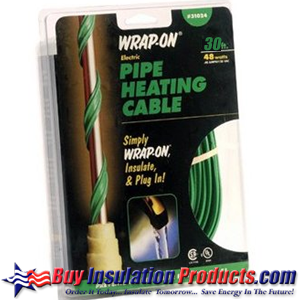Prevent Frozen Pipes with Wrap-On Pipe Heating Cables
Posted by BIP on 31st Oct 2016

If you have ever been unlucky enough to deal with a frozen pipe in your home, you understand the importance of preventing a pipe from freezing this winter. A pipe that freezes not only stops water flow, it can also lead to a pipe burst. At first you will not notice a water leak, however once the pipe thaws out, it can lead to serious water damage.
Myth #1 Pipe Insulation will Prevent Pipes from Freezing (FALSE)
Although pipe insulation will slow down the freezing process, if water is standing in a pipe that is surrounded by freezing temperatures for a long enough time, the pipe will freeze. What pipe insulation will do is slow down the freezing process which could help if the water will be continually flushed.
Myth #2 Keeping your Faucet Dripping will Prevent Pipes from Freezing (FALSE)
We do recommend to keep faucets dripping on pipes that may freeze however this is not a fool proof plan. If the temperatures are cold enough, a pipe that is dripping at the faucet will steel freeze. Regularly flushing the pipe will help however it's not practical to continually flush the pipe throughout each cold winter night.
The biggest problem with the two common myths listed above is both lack a heat source. The proven way to prevent a pipe from freezing is by keeping the temperature of the water inside the pipe above 32F. This can be accomplished by heating the room the pipe is in (usually basement or garage) If a pipe is located in a space that is not regularly heated, the easiest solution is to add a Pipe Heating Cable as your heat source.
What is a Pipe Heating Cable?
A pipe heating cable is similar to an extension cord which is wrapped around a pipe and is then covered with pipe insulation. Pipe heating cables plug into three prong electrical outlets like an regular extension cord. A heat regulating thermostat is located at the end of the cord which is left outside of the pipe insulation. The thermostat will turn the cable on and off to regulate the temperature of the pipe and remain energy efficient. The thermostat also includes a test button and an on light which will shine when the cable is turned on. Wrap-One Pipe Heating Cables can prevent frozen pipes in temperatures as low as -50F!
Why use Pipe Insulation over a Pipe Heating Cable?
Fiberglass Pipe Insulation will prevent heat loss from the pipe wrap heater and direct the heat towards the pipe rather to the air surrounding the pipe. The insulation will also slow down the heat loss from the pipe which will allow the heating cable to turn off for longer periods of time which saves energy and money as well as extends the life of the heating cable.
Will Pipe Insulation fit over a Pipe Heating Cable?
This is a common issue we run into with customers insulating over heating cables. Because the heating cable is spiraled around the pipe, the diameter for the pipe and cable is larger. The larger diameter usually requires the next size up of pipe insulation to be used. For example, if you have a 1" pipe with a pipe wrap heater, we would recommend ordering pipe insulation for 1-1/4" pipe instead.
VIDEO: How to Wrap Outdoor Pipes to Prevent Freezing Using Pipe Heating Cables



